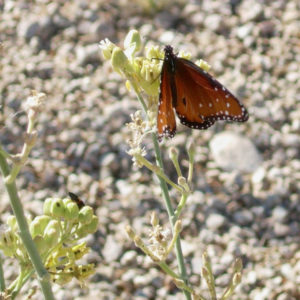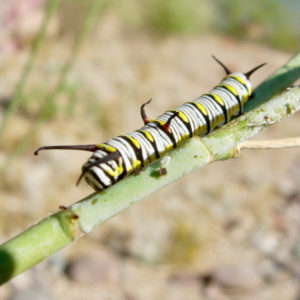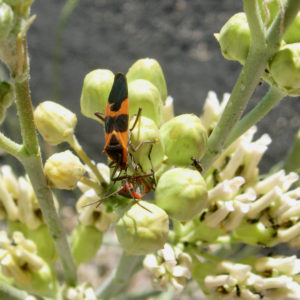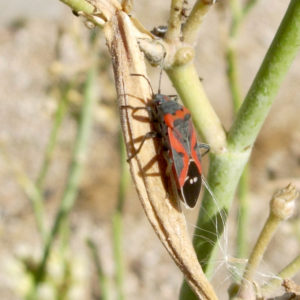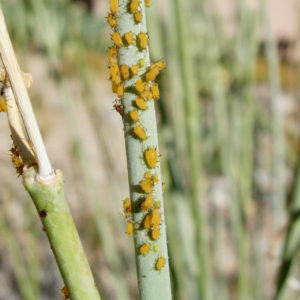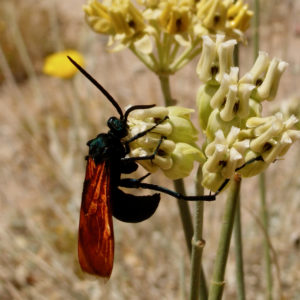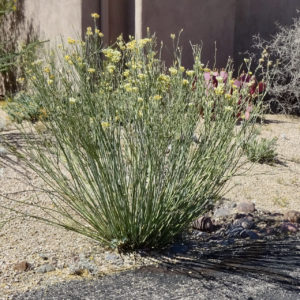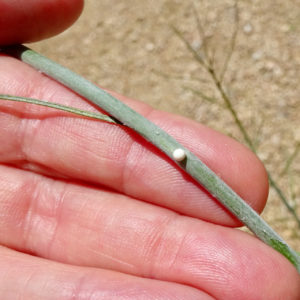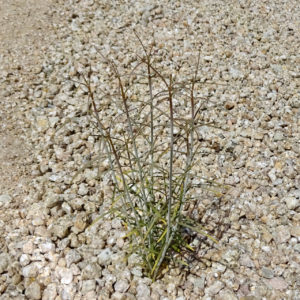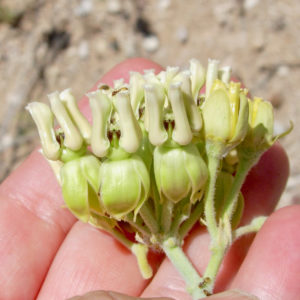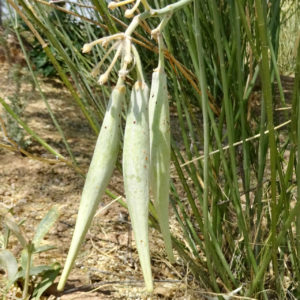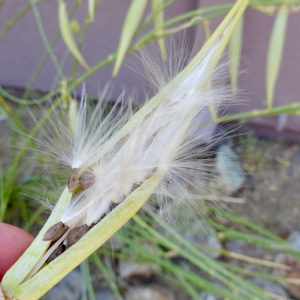Desert Milkweed
Asclepias subulata
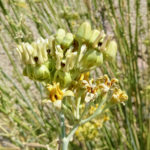
About the Plant
NOTE: desert milkweed is considered poisonous and can pose a danger to cats, dogs, and humans.
Desert milkweed grows in the hot deserts of Arizona, California, and Nevada. Looking like a 3-4 foot collection of green twigs, it provides a vertical accent in the garden and is at home near cactus and other desert natives. Desert milkweed flowers from late spring and into fall, attracting a wide variety of insects. The long seed pods open to release fluffy seeds that float in the wind and will happily germinate near your irrigated plants.
Grow desert milkweed in full, or nearly full, sun. It needs well-drained soil. Once established, desert milkweed can grow on natural rainfall but may perform better if irrigated occasionally during the hottest, driest part of the year. Excess irrigation will create a tall, floppy plant and increase the likelihood of aphids. To rejuvenate overgrown plants, cut back at ground level in late winter. Never shear, as cut stems may die rather than branch and grow.
Notes:
- It is best to consider this plant at least mildly toxic. It can present a danger not only to livestock but to dogs and cats also. Wash your hands thoroughly after handling the plant, especially if you have damaged the stems so the milky sap is released.
- Desert milkweed is sometimes listed as native to Pima County, Arizona, though I have never seen it growing wild in the Tucson area (see map listed below under More Information). Other resources list it as native only to La Paz, Maricopa, Mohave, Pinal, and Yuma Counties. There are no collections from Pima County listed in the UA Herbarium database.
Wildlife value:
Desert milkweed flowers attract a variety of insects, including:
Queen butterflies. The adults feed on the flowers and the caterpillars eat the stems.
Milkweed bugs, both large (first photo below) and small. They feed on the seeds and are often seen on the pods.
Oleander aphids. These insects do little damage and can be removed with a strong stream of water. Limiting irrigation will reduce the succulent growth the aphids prefer. Don't fertilize the plant.
Tarantula hawks. These 2 inch wasps have metallic blue-black bodies and shiny red wings. Count on them finding your desert milkweed when it starts to flower. Some sources state that these wasps are major pollinators of desert milkweed. Tarantula hawks are docile; I have walked among them many times without them paying the least attention. Do not provoke them, though (e.g. don't grab or swat them). Their sting is very painful.
More Information
Weekly Plant on desert milkweed
Technical botanical description from SEINet
In books:
Perennials for the Southwest by Mary Irish, page 102
Native Plants for Southwestern Landscapes by Judy Mielke, page 79
ID Characteristics
Desert milkweed grows to 3-4 feet in height. New stems are added at ground level as the plant grows.
The stems are grey-green with a white bloom that can be rubbed off (they are glaucous), up to 1/4 inch in diameter. If the stem is damaged, a white sap is released.
The opposite leaves of desert milkweed are quickly deciduous, found only on young plants before flowering and occasionally on larger plants if water is ample. Each leaf is 2 inches long but only 1/8 inch wide.
The flower cluster is an umbel, with several flowers arising from the same point creating a flat-top cluster, about 2 x 2 inches. The umbels are at the end of the stems and several umbels may be clustered together.
Desert milkweed has typical milkweed flowers, with the sepals small and triangular at the base of the petals (see unopened flower to the right in photo) and the green petals reflexed down when the flower is open. The hood is cream to yellow-colored and extends above the rest of the flower, about 1/4 inch long. Milkweed flowers have an unusual structure. See this article for detailed drawings (scroll down to example #4). See the Weekly Plant article for a close-up photo of the pollinium (the pollinia are less than 1/10 inch long).
The seed pods (fruit) of desert milkweed are long and pointed, often over 4 inches long but only about 1/2 inch wide.
When the seeds are mature, the pods open along a single suture. The seeds are gradually released. Each flattened seed is dark brown, 1/8 to 1/4 inch in length. Many fine white hairs, each about 1/2 inch in length, are attached to one end of the seed, allowing the seeds to float away on the wind.
